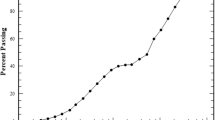Abstract
The effects of pressure and cake thickness were studied using a split-plot design for pressure filtration of a fine refuse slurry obtained from a bituminous coal preparation facility. Pressure filtration offers the potential to significantly reduce the moisture content of the fine refuse stream with the addition of little to no flocculants, thereby minimizing the volume of refuse stored in impoundments and providing a recycle water stream for use within the plant. Experimental results showed that the final cake moisture decreased with increase in pressure and decrease in cake thickness. In addition, specific cake resistances calculated for the various tests indicated an increasing trend with increasing pressure and decreasing cake thickness. With increase in cake thickness, an increase in cake moisture and the weight of solids deposited in the cake was observed. An ANOVA analysis indicated that both cake thickness and pressure significantly affected the cake moisture, while only cake thickness statistically influenced the weight of solids in the cake. A regression model was developed with an R2 value of about 0.99 to relate cake thickness, the single largest statistically significant factor, with the weight of solids in the cake. Filter capacities were calculated in terms of the solids deposited per unit time based on a product specification of 25 percent cake moisture, and it was observed that the thinnest cake had the highest filter capacity.
Similar content being viewed by others
References
Alam, N., Ozdemir, O., Hampton, M., and Nguyen, A., 2011, “Dewatering of coal plant tailings: Flocculation followed by filtration,” Fuel, Vol. 90, No. 1, pp. 26–35, https://doi.org/10.1016/j.fuel.2010.08.006.
Arnold, B.J., 1999, “Simulation of dewatering devices for predicting the moisture content of coals,” International Journal of Coal Preparation and Utilization, Vol. 20, No. 1–2, pp. 35–54, https://doi.org/10.1080/07349349908945591.
Endo, Y., and Alonso, M., 2001, “Physical meaning of specific cake resistance and effects of cake properties in compressible cake filtration,” Filtration and Separation, Vol. 5, September, pp. 42–46, https://doi.org/10.1016/s00151882(01)80447-x.
Gardner, J.S., Houston, K.E., and Campoli, A., 2003, “Alternative Analysis for Coal Slurry Impoundments,” 2003 SME Annual Meeting, Society for Mining, Metallurgy & Exploration Inc., Englewood, CO, pp. 1–5.
Hahn, J., 2012, “Performance, operation, and maintenance experience of coal ultrafines filtration with modern high-speed disc filters,” Challenges in Fine Coal Processing, Dewatering, and Disposal, M.S. Klima, B.J. Arnold and P.J. Bethell, eds., Society for Mining, Metallurgy & Exploration Inc., Englewood, CO, pp. 261–278.
Klima, M.S., and Raman, G.S.S., 2015, “Putting the press on ultrafine coal refuse,” World Coal, Surrey, October, pp. 19–22.
Klima, M.S., Raman, G.S.S., Ganter, J., Smith, J., Hellgren, L., and Pollack, J., 2015, “Evaluation of bench-scale pressure filtration when dewatering coal refuse slurry,” Second Environmental Considerations in Energy Production Conference, J. Craynon, ed., Society for Mining, Metallurgy & Exploration Inc., Englewood, CO, pp. 1–11.
de Korte, G.J., 2008, “Dewatering of Ultra-fine Coal with Filter Presses,” Council for Scientific and Industrial Research, Pretoria, South Africa, pp. 1–15.
Landman, K.A., Sirakoff, C., and White, L.R., 1991, “Dewatering of flocculated suspensions by pressure filtration,” Physics of Fluids A: Fluid Dynamics, Vol. 3, No. 6, pp. 1495–1509, https://doi.org/10.1063/1.857986.
Mullins, R., Eraydin, M.K., and Blubaugh, S., 2012, “OreBind technology for limiting waste fines disposal in impoundments and slurry cells,” Separation Technologies for Minerals, Coal, and Earth Resources, C.A. Young and G.H. Luttrell, eds., Society for Mining, Metallurgy & Exploration Inc., Englewood, CO, pp. 111–114.
Patwardhan, A., Chugh, Y.P., Arnold, B.J., and Terblanche, A.N., 2006, “Dewatering ultrafine clean coal in a T. H. filter press,” Coal Preparation, Vol. 26, No. 1, pp. 33–54, https://doi.org/10.1080/07349340600620004.
Perlmutter, B.A., 2002, Evaluating Thin-Cake Pressure Filtration Using the BHS Autopress Technology, Putnam Media Inc., Charlotte, NC, https://doi.org/www.bhsfiltration.com/autopress_thin_cake_pressure_filtration.pdf.
Prat, G., 2012, “Dewatering fine coal and tailings with a filter press,” Challenges in Fine Coal Processing, Dewatering, and Disposal, M. Klima, B. Arnold and P. Bethell, eds., Society for Mining, Metallurgy & Exploration Inc., Englewood, CO, pp. 279–292.
Raman, G.S.S., and Klima, M.S., 2017a, “Application of artificial neural networks for evaluating pressure filtration of coal refuse slurries,” Mineral Processing and Extractive Metallurgy Review, Vol. 38, No. 1, pp. 47–53, https://doi.org/10.1080/08827508.2016.1244060.
Raman, G.S.S., and Klima, M.S., 2017b, “Evaluation of pressure filtration of coal refuse slurry: A fractional factorial design approach,” International Journal of Coal Preparation and Utilization, https://doi.org/10.1080/19392699.2017.1329726.
Raman, G.S.S., Klima, M.S., and Bishop, J.M., 2017, “Pressure filtration: Benchscale evaluation and modeling using multivariable regression and artificial neural network,” International Journal of Mineral Processing, Vol. 158, pp. 76–84, https://doi.org/10.1016/j.minpro.2016.11.020.
Smith, C.B., and Townsend, I.G., 2002, “Testing, sizing and specifying of filtration equipment”, Mineral Processing Plant Design, Practice, and Control, Vol. 2, A.L. Muler, D.N. Halbe and D.J. Barrett, eds., Society for Mining, Metallurgy & Exploration Inc., Englewood, CO, pp. 1313–1330.
Tarleton, E.S., and Willmer, S.A., 1997, “The effects of scale and process parameters in cake filtration,” Trans IChemE, Vol. 75, No. A, pp. 497–507, https://doi.org/10.1205/026387697524001.
Teoh, S.K., 2003, “Studies in Filter Cake Characterisation and Modelling,” Ph.D. Dissertation, National University of Singapore, Singapore.
Author information
Authors and Affiliations
Additional information
Paper number MMP-17-078.
Discussion of this peer-reviewed and approved paper is invited and must be submitted to SME Publications Dept. prior to Feb. 28, 2019.
Rights and permissions
About this article
Cite this article
Raman, G.S.S., Klima, M.S. Effects of cake thickness and pressure on the filtration of coal refuse slurry. Mining, Metallurgy & Exploration 35, 125–132 (2018). https://doi.org/10.19150/mmp.8461
Received:
Accepted:
Published:
Issue Date:
DOI: https://doi.org/10.19150/mmp.8461




